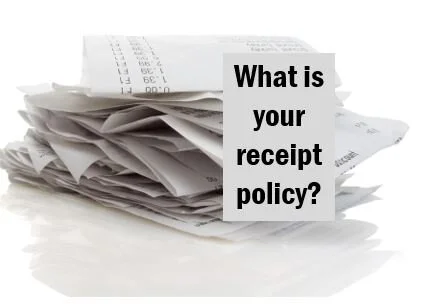Receipts and similar supporting documentation for card transactions are an important control. Take a look at your current requirements. The risk of internal fraud within your card program increases if the receipt policy is too vague, if missing receipts are excused, and if no one is monitoring policy violations. This post shares ways to make your policy stronger, regardless of how or where receipts are retained. For one, you may want to rethink the use of a “missing receipt form.” More on that below.
What Constitutes an Appropriate Receipt?
A “receipt” could be any documentation from the vendor that meets the requirements listed below; for example, a priced packing list indicating a card payment was made. The important part is the details. Ensure your policy specifies that every receipt should legibly reflect:
transaction date
vendor/merchant name and location
total amount charged and the tax amount charged
what was purchased, including a listing of each item, the quantity, and unit price
When it comes to food/meal receipts, Chad Robison, MBA, CPCP, P-Card, T&E, and ePayables Program Manager, Intermountain Healthcare, recommends requiring additional detail. He explains, “Some food orders are placed by one person, such as an admin, but the food is delivered to a meeting where someone else receives it and tacks on a huge tip. We require both food-related receipts in order to see what was ordered and the tip amount.”
When is a Receipt Required?
Some organizations require a receipt for every transaction. Others have a receipt threshold, so that only purchases over “X” amount require a receipt. Consider the costs versus benefits of both approaches before making a final decision. A threshold saves labor costs associated with receipt management and may increase cardholders’ satisfaction with the program. The drawback is that small-dollar fraud—purchases below the receipt threshold—can go undetected and quickly add up.
One option to reduce the risk is for your policy to specify that receipts must be retained for every purchase, but only have to be submitted/uploaded for purchases above “X” amount. Further, state that transactions of all sizes are subject to auditing and that cardholders will occasionally be asked to show receipts for purchases below the threshold. Ensure each cardholder is audited for receipts for all transaction sizes at least once per year. This leads to the next point.
What Happens in Cases of Missing Receipts?
Providing a “missing receipt form” to cardholders who lose receipts has been a common practice historically, but it is time to be more thoughtful about this. Chad Robison points out that missing receipts could be a red flag, especially since it is pretty easy in this digital age to obtain a copy of a receipt from vendors like Amazon and others. Indeed, many cases of internal card fraud include instances where the cardholder failed to provide a receipt. Both Chad and I agree that missing receipts—when a receipt is required per policy—should be treated as a policy violation and that a certain number of such violations warrant retraining as a first step. The consequences could escalate from there.
Doug Hindsley, Senior Partner, Card Integrity, agrees with tracking these violations, but also observes that a missing receipt form can still add value. He explains, “Balance a cardholder’s time [to chase down a missing receipt] with the transaction amount, which is often small in a P-Card program. A missing receipt form might be more cost effective in some situations, as well as help prevent receipt fabrication by a cardholder.”
Final Thoughts
Every organization should:
Take receipt violations seriously.
Determine, in advance, the tolerance for missing receipts—at what point there should be consequences.
State what the consequences could be within your program policies and procedures, and within the training.
Monitor the related metrics (e.g., percentage of transactions that are not compliant with the receipt requirements).
Consistently enforce the rules.
Available Products & Services from Recharged Education
Submit a contact form to request a quote for what your organization needs.
Subscribe to the Blog
Receive notice of new blog posts.
About the Author
Blog post author Lynn Larson, CPCP, launched Recharged Education in 2014. With 20 years of Commercial Card experience, her mission is to make industry education readily accessible to all. Learn more…

